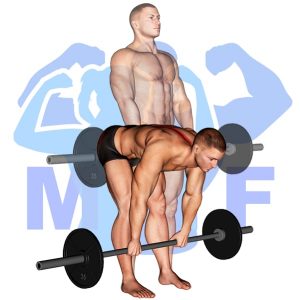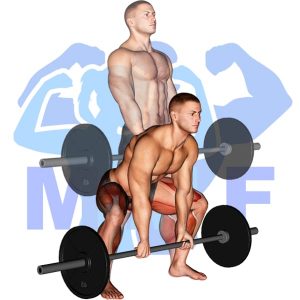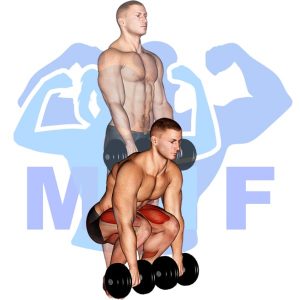Are you struggling with the barbell high bar squat? Do you find it difficult to maintain proper form and depth in your squats? You’re not alone. Many people struggle with this particular exercise, and it’s often due to a lack of mobility and flexibility. The good news is, there are ways to improve your squat form and prevent injury. In this post, we’ll discuss some common mistakes people make when performing the barbell high bar squat, the causes behind those mistakes, and some tips to improve your technique. By the end of this post, you’ll be on your way to mastering the barbell high bar squat and making serious gains in your leg strength.
Barbell High Bar Squat Summary
- Primary Muscles: Quadriceps
- Secondary Muscles: Adductor Magnus, Gluteus Maximus, and Soleus
- Equipment: Barbell
- Mechanics Type: Compound
- Force: Push
- Utility: Basic

Barbell High Bar Squat Instructions
- A high bar squat has the bar resting on top of your traps, positioning the bar higher will make you pivot at your hips more during the squat to keep the bar directly over the middle of your feet.
- To setup position the bar on your traps, you can make a stable base by grabing the bar and pulling your hand together without them moving on the bar.
- Once you have a stable base the bar resting on you traps, un-rack the bar and step into a position standing with your feet directly under your hips, and your knees and feet slightly pointed out.
- You are ready to squat down until your hip joint is lower than the top of your knee. You will do this by pivoting at your hips and knees simultaniously, and moving the bar in a straight vertical line.
- Then press the bar back up to standing position and do it all again.
Video Tutorial
Barbell High Bar Squat Muscles
Target (Agonist)
Synergists
- Adductor Magnus
- Gluteus Maximus
- Soleus
Dynamic Stabilizers
Stabilizers
- Erector Spinae
- Levator Scapulae
- Trapezius – Middle
- Trapezius – Upper
Antagonist Stabilizers

Benefits of Barbell High Bar Squat
The Barbell High Bar Squat is an essential exercise for strength training, as it is a compound movement that targets multiple muscle groups. It is especially beneficial for targeting the Quadriceps muscles, as it provides an intense workout and can help to build overall strength. This exercise is effective for developing power in the legs and improving balance, coordination, and mobility. Additionally, the Barbell High Bar Squat can help to increase joint flexibility and reduce the risk of injury. As an added benefit, this exercise has been shown to improve posture and even aid in weight loss.
Tips for Performing Barbell High Bar Squat
If you are looking to improve your strength and athleticism, the barbell high bar squat is an exercise you should definitely consider. Not only does it build strength in the quads and core, but it also helps increase mobility and stability. To get the most out of this exercise, try following the tips below for proper form and technique.
- Inhale While You Extend Your Muscular Tissues And Exhale When You Contract Your Muscle.
- Use A Cage With The Appropriately Set In Place Safety Bars. With proper safety, you will motivate yourself farther and your pump will climb.
- Conduct Drop Sets. You can amplify your muscle development by utilizing drop sets. A drop set is whenever you lift to until you can do another rep then you lighten the weight and keep going. You are able to lower the load numerous times.
- You Should Make Sure That You Program Recovery Days. When you still want to exercise, instead of recovery you could incorporate into your program with rowing. Only remember to permit your muscles to repair, healing is the only time your muscles grow.
- Always Keep Your Abs Tight. For most exercises, you will need to reinforce your backbone by flexing your stomach to strengthen your inner pressure near your backbone.
Benefits and Tips Video
Frequent Mistakes To Avoid
When it comes to barbell high bar squats, there are many mistakes that can be made if proper technique is not followed. To get the most out of your workout, it is important to avoid these common mistakes in order to maximize your fitness goals. Below is a list of mistakes to avoid when performing the barbell high bar squat.
- Don’t Neglect Your Own Pains. Stiff and sore muscle tissue and an injury pain are not necessarily always the same. As soon as you appear discomfort any time you are exercising you will want to stop, or you can simply just mhelp make this injury even worse.
- You’ll Do Better To Not Conduct The Same Lifts Each And Every Occasion. Whenever people execute exactly the same exercise every work out your muscle groups will be conditioned to perform that sole lift well, and you will peak more quickly.
- You Can’t Forget Your Cooldown. You will minimize your healing time frame and help reduce soreness for those who accomplish a proper cool down.
Find More Barbell Exercises Here
Variations and Complementary Exercises
It is important to incorporate variation into your workouts to keep your body challenged and to avoid plateauing. To complement the Barbell High Bar Squat, the following exercises should be included in your routine.
Barbell Low Bar Squat

The Barbell Low Bar Squat is a great complement or alternative to the Barbell High Bar Squat. This exercise targets the same muscles as the High Bar Squat but with a greater emphasis on the posterior chain muscles, such as the glutes and hamstrings. The lower bar placement on the back also allows for a greater range of motion, allowing you to go deeper and work the glutes and hamstrings more effectively. The Low Bar Squat also requires more trunk stability due to the wider stance and higher center of gravity, which helps to increase core strength and stability.
Barbell Narrow Squat

The Barbell Narrow Squat is a great complementary or alternative exercise to the Barbell High Bar Squat. It requires you to use a narrower stance, which puts more emphasis on your quads, as opposed to the wider stance used in the Barbell High Bar Squat which places more emphasis on your glutes and hamstrings. Additionally, the narrower stance allows you to maintain a more upright torso position during the lift, which helps keep your back safe and your core engaged. Lastly, the Barbell Narrow Squat is great for developing lower body strength and stability.
Barbell Olympic Squat

Barbell Olympic Squat is a great complementary or alternative exercise for the Barbell High Bar Squat. This exercise places the barbell on the back of the shoulders, just below the neck, and requires you to squat down until your hips are just below the knees, before pushing up and standing back up. This exercise will help you build leg strength, balance, and coordination, as well as help you develop your core and glutes. It’s also a great way to add variety and spice to your routine.
Check Out These Top Barbell Exercises
Barbell Quarter Squat

The Barbell Quarter Squat is a variation of the Barbell High Bar Squat that can be used as an alternative or complementary exercise. By lowering the bar only halfway, the body is forced to move through a reduced range of motion, emphasizing the quads and glutes over the hamstrings. This exercise is perfect for targeting specific muscles and for those who may lack the flexibility or mobility to perform a full Barbell High Bar Squat.
Barbell Squat to Shoulder Press

Barbell Squat to Shoulder Press is an excellent complementary or alternative exercise for the Barbell High Bar Squat. This exercise combines two different movements into one, and works many muscles at once. By performing this exercise, you are able to target the same muscles as the high bar squat, but with an extra emphasis on the shoulders and triceps. The barbell squat to shoulder press is an effective way to increase strength, stability, and balance while working on your upper body at the same time.
Barbell Sumo Squat

The Barbell Sumo Squat is a great alternative or complementary exercise to the Barbell High Bar Squat. It is a variation of the traditional squat that emphasizes the inner thigh and gluteal muscles, while reducing the stress on the hips and lower back. The sumo squat is performed by placing the feet wider than shoulder-width apart and pointing the toes outwards at a 45-degree angle. This exercise also involves a deep squat with the spine in a neutral position and the barbell held close to the body. The Sumo Squat is an effective exercise for strengthening and toning the legs, glutes, and core muscles. It can be used to increase power, improve balance, and develop overall strength and stability.
Find More Legs Exercises Here
Opposing Complementary Exercises
It is important to use opposing muscle groups to help balance your strength and prevent injury. To complement the Barbell High Bar Squat, here are a few exercises that work the opposing muscle groups:
Barbell Stiff Legged Deadlift

The Barbell Stiff Legged Deadlift is a complementary exercise to the Barbell High Bar Squat as it targets opposing muscle groups. This exercise works the hamstrings, glutes, and lower back to strengthen the posterior chain, while the Barbell High Bar Squat is focused on developing strength in the quadriceps and glutes. The combination of these two exercises can help to develop a balanced lower body strength profile. Additionally, the Barbell Stiff Legged Deadlift can also help to improve stability and balance, and increase flexibility in the hips and hamstrings, making it an excellent addition to any lower body workout.
Barbell Sumo Deadlift

The Barbell Sumo Deadlift is an excellent complement to the Barbell High Bar Squat as it works the opposing muscle groups. This exercise works the hamstrings, glutes, and adductors as the primary muscle groups while also engaging the core, back, and traps. By performing this exercise alongside the Barbell High Bar Squat, you can ensure that your body is getting a full range of motion in both the front and back of your legs. This will help to improve your overall strength and power while also reducing the risk of injury.
Dumbbell Deadlift

The Dumbbell Deadlift is a great complementary exercise to the Barbell High Bar Squat. It works the opposing muscle groups of the legs, primarily targeting the hamstrings, glutes and lower back. This helps to balance out the strength in your lower body, as the Barbell High Bar Squat works the quads, glutes and core. The Dumbbell Deadlift also engages the arms, shoulders and upper back, making it a great full-body exercise that can help to increase overall strength and power.
Maximize Your Results with High Bar Squats
If you’re looking to take your leg workouts to the next level, you need to try high bar squats. This exercise is one of the best ways to build strength and muscle in your legs, but it also works your core, glutes, and back. To ensure you’re maximizing your results and avoiding injury, make sure you’re maintaining proper form throughout the exercise. Keep your knees aligned with your toes, your back straight, and your core tight. Start with a lighter weight and gradually increase as you get more comfortable with the movement. Remember, quality over quantity is key.
References: Wikipedia | ExRx.net | PubMed.gov | Comprehensive List of Legs Barbell Exercises




